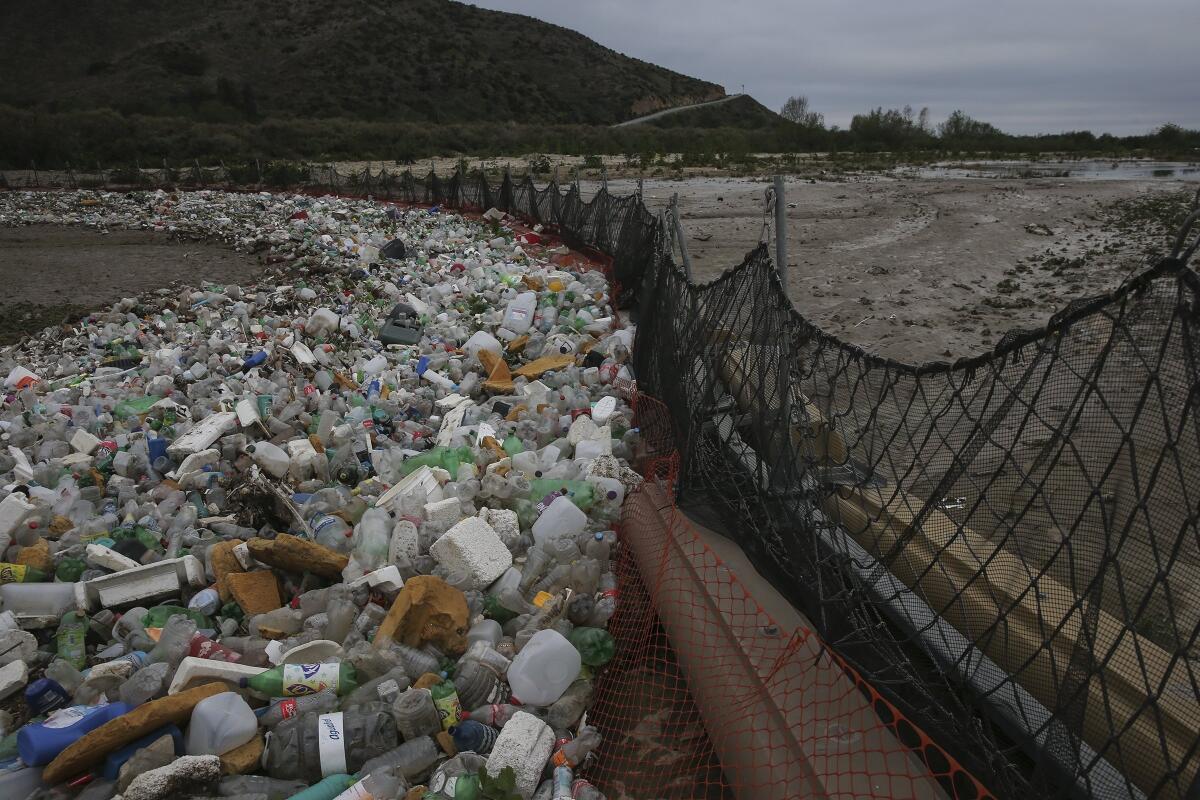Unlikely allies got White House to tackle Tijuana River mess: How they pulled it off

- Share via
For decades, millions of gallons of raw sewage and trash have flowed from the Tijuana River to the Pacific Ocean, fouling beaches, angering Southern Californians and getting worse by the year.
An estimated 143 million gallons of waste from Tijuana spilled into the river valley in 2017, overwhelming a treatment plant built by the United States and Mexico nearly 25 years ago. Last October, a corpse clogged a sewage intake screen, causing a backup and sending 14.5 million gallons of polluted water over the border and into the U.S.
Yet neither country has been willing to spend the money to expand the plant. Then President Trump renegotiated the North American Free Trade Agreement with Mexico and Canada in late 2018. He needed the approval of Congress. That was the opening local groups at the border needed to resolve the environmental disaster.
When Trump signed legislation last month implementing the new agreement known as the USMCA, it included a provision authorizing $300 million to try to stop the cross-border sewage flows.
With the support of an unusual mix of local Democrats, Republicans, Border Patrol agents and environmental groups, House Democrats leveraged their support for the trade bill — one of Trump’s highest priorities — to secure the administration’s rare backing for an environmental project.
Each group played a part. Democrats in Congress drafted legislation to provide money and legal authority to address the spills, hoping to add it to the trade bill. San Diego’s Republican mayor, Kevin Faulconer, met with the president to plead the case. Environmentalists emphasized the health risks of the pollution, and Border Patrol agents at the Imperial Beach Station made public their complaints of rashes, burning eyes and sore throats.
The advocates’ pitch for federal money was not a simple ask, given that it involved frequent targets of the president’s ire. Trump has warred for three years against Mexico’s and California’s leaders on a range of issues. At the behest of farmers and real estate developers, his administration has weakened federal regulations protecting water quality.
“We used his ambition for a new trade agreement to get what we wanted,” said Rep. Jimmy Gomez (D-Los Angeles), who was one of the lawmakers who negotiated with administration officials. “And in the end, it benefits, of course, the entire country and all Americans. But I think if [Trump] had a choice, it wouldn’t have been in there.”
A spokesman for Robert Lighthizer, the United States trade representative, said the administration was open to the project from the beginning. But House Democrats said the administration turned them down when they first sought $400 million to expand and upgrade the South Bay International Wastewater Treatment Plant, though Trump’s advisors didn’t dispute that the sewage overflows were making people sick along the border.
The request was a “non-starter,” administration officials told the group, according to Rep. Earl Blumenauer (D-Ore.), chairman of the House subcommittee with jurisdiction over trade legislation.
Faulconer, who met with Trump at the White House last summer to ask for funding, said the administration offered only $40 million — a tenth of what experts estimated was needed. Faulconer said he continued to push, appealing to Trump’s desire to deliver on a campaign promise of a new and improved NAFTA.
“We weren’t looking for a down payment,” he said. “We were looking for an amount that would get us what we need. I said, ‘Mr. President, we can fix this.’”
Trump offered him no assurances, however.
In the months of haggling that followed, four Democratic lawmakers from the San Diego area — Reps. Mike Levin, Susan A. Davis, Scott Peters, and Juan Vargas — turned up the pressure on Blumenauer and other House trade-bill negotiators to make the border project among their top demands.
Vargas loudly threatened to oppose the USMCA bill and Levin refused to say anything positive about it, suggesting that he might oppose it, too.
By mid-summer, the four lawmakers had drafted legislative language, and they lobbied other House Democrats to make it their top environmental priority for the legislation giving Congress’ approval to the three countries’ trade agreement. Mexico’s lawmakers have ratified the trade deal, but the issue is pending in Canada.
Vargas said that Levin, a freshman lawmaker, was “like a dog with a bone” on the issue. Levin said he would purposely run into Blumenauer in the House members’ gym to quiz him on where the funding request stood in the negotiations.
Seeking additional leverage, Davis, a senior member of the House Armed Services Committee, urged the administration to consider the national security consequences. With the Navy building a new training complex close to Imperial Beach, SEALs would be operating near where sewage spills into the ocean.
Vargas said the Navy refused to take a public position on the issue — doing so would acknowledge that its new facility was in a potentially contaminated area — but quietly made its support known to the administration.
Davis “did a great job of getting the military involved,” Vargas said. A Navy spokesman disputed this account, however, writing, “The Navy has not been lobbying or working ‘behind the scenes’ for funding to address Tijuana River pollution issues.”
The Border Patrol, far from staying silent, was actively involved in drawing attention to the pollution.
Its agents have suffered from continuous exposure to the river’s fumes, and polluted water has been known to dissolve the glue on agents’ boots, according to Amber Craig, a Border Patrol agent and public lands liaison. The agency tested the water to document the high concentrations of E. coli bacteria, heavy metals and pesticides so dangerous that they’re banned in the U.S.
Craig and other agents worked with San Diego’s elected officials and the Surfrider Foundation, an environmental organization dedicated to protecting the coast, to advocate for funding to stop the sewage spills.
“Border Patrol and Surfrider don’t seem like they’d have anything in common,” Craig said, “but we’re all just great partners.”
Democratic lawmakers said Border Patrol agents and the Navy were crucial to winning the administration’s support.
The Democrats wielded considerable influence given their majority in the House, and they sought environmental gains beyond the Tijuana River cleanup. But the Democratic negotiators were caught between progressives’ demands for Mexico to adopt stronger environmental rules and the Mexican negotiators’ opposition at a time when Trump is weakening environmental safeguards in his country.
“The Trump administration undercut us in terms of their not taking environmental protections seriously,” Blumenauer said. “It looked like we were being hypocritical.”
As a result, federal funding to lessen the sewage flows was the only significant environmental victory to emerge from the trade negotiations.
When final talks began late last year among Lighthizer, House Speaker Nancy Pelosi (D-San Francisco) and Rep. Richard E. Neal (D-Mass.), who chairs the House Ways and Means Committee, it was clear the Tijuana River cleanup would be addressed in the trade deal.
With Pelosi making the issue a priority, opposition had melted away.
The amount of money was among the final issues decided, just days before the legislation was announced on Dec. 10, according to several people familiar with the negotiations.
The Senate and House each passed the ratification measure. When Trump signed it on Jan. 29, some California officials declared victory. Faulconer attended the signing ceremony at the White House, and later said that the money would be used to clean up the sewage spills “once and for all.”
However, others stressed that the drive to reduce the sewage spills is not over.
The $300 million still is $100 million less than experts say is needed for a system capable of reducing cross-border pollution by about 95%. And the sum hasn’t been allocated to specific purposes yet.
Yet everyone involved in the negotiations was certain of one thing: The U.S. couldn’t wait any longer for Mexico to repair its crumbling infrastructure. The new trade deal is expected to give rise to additional factories at the border, bringing more people to Tijuana — and more refuse to the river valley.
More to Read
Get the L.A. Times Politics newsletter
Deeply reported insights into legislation, politics and policy from Sacramento, Washington and beyond. In your inbox three times per week.
You may occasionally receive promotional content from the Los Angeles Times.












